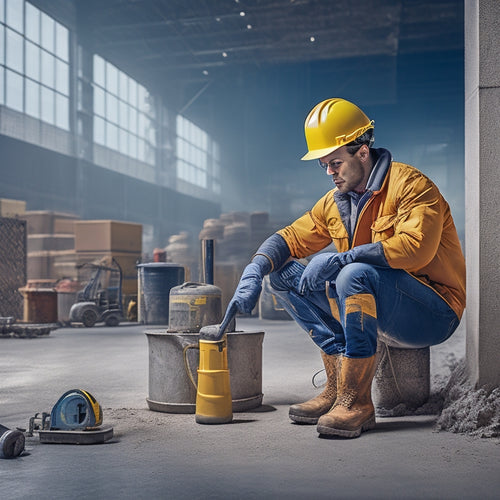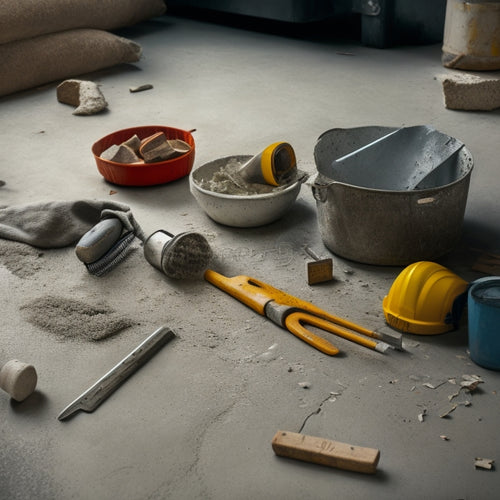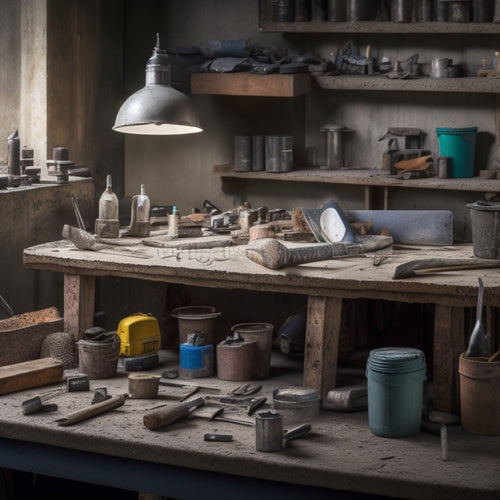
7 Best Tools for Building Concrete Walls at Home
Share
When building concrete walls at home, you'll need a range of tools to guarantee a successful project. Essential mixing and measuring tools like digital scales, mixing sticks, and clean equipment are vital for accurate concrete mixing. Formwork and molding equipment such as traditional forms, ICFs, and reusable plastic forms help you achieve the desired wall shape. Additionally, you'll need concrete finishing and smoothing tools, reinforcement and anchoring systems, safety gear, power tools for concrete cutting, and compaction and leveling devices. By mastering these tools, you'll be well on your way to constructing a strong and durable concrete wall; investigate further to uncover the subtleties of each tool and how they can enhance your project.
Key Takeaways
- Essential mixing and measuring tools, like digital scales and mixing drums, ensure accurate concrete mixtures for strong walls.
- Formwork and molding equipment, including ICFs and reusable plastic forms, help create desired wall shapes and structures.
- Specialized tools, like trowels and floats, are necessary for achieving a high-quality, smooth finish on concrete walls.
- Reinforcement and anchoring systems, including rebar and anchor bolts, provide added strength and stability to concrete walls.
- Safety gear, such as hard hats and respirators, are crucial for protecting yourself from hazards during the concrete wall building process.
Essential Mixing and Measuring Tools
When constructing concrete walls, a thorough mixing process is vital to achieve the desired strength and consistency. You'll need to get the mixing ratios just right, and that requires accurate measuring techniques.
Start by investing in a digital scale or a high-quality measuring bucket to guarantee precise measurements of cement, sand, and aggregate. A mixing stick or trowel is also essential for combining the ingredients thoroughly.
Next, you'll need a mixing drum or wheelbarrow large enough to hold the required volume of concrete. Make certain it's clean and free of any debris that could affect the mix. A mixing paddle or drill with a mixing attachment can help you achieve a consistent mix.
Don't forget to wear protective gear, including gloves, safety glasses, and a dust mask, to prevent injury and exposure to hazardous materials.
With the right tools and attention to detail, you'll be able to achieve a strong, durable concrete wall that meets your project's requirements.
Formwork and Molding Equipment
You'll need to decide on a forming technique, such as slip forming, jump forming, or climbing formwork, to shape your concrete wall.
The chosen method will influence your wall molding options, which can range from simple, straight walls to complex, curved designs.
Forming Techniques
Forming techniques, comprising formwork and molding equipment, play an essential role in building concrete walls by providing a mold for the freshly poured concrete to take shape.
As you plan your concrete wall project, you'll need to decide on the forming technique that suits your needs. You can opt for traditional forming methods, such as using wooden or steel forms, or investigate alternative forming techniques that offer more creative freedom.
For instance, you can use insulated concrete forms (ICFs) or structural insulated panels (SIPs) to create walls with built-in insulation and added structural integrity.
Another option is to use reusable plastic forms or modular forming systems, which can be customized to fit your design requirements.
When choosing a forming technique, consider factors such as cost, labor requirements, and the desired finish.
Wall Molding Options
Selecting the right wall molding options is vital for achieving a high-quality concrete wall that meets your project's specifications. You'll need to choose from various molding materials, each with its own strengths and limitations.
For instance, steel molds offer high strength and durability, making them ideal for large-scale projects. Aluminum molds, on the other hand, are lightweight and corrosion-resistant, making them suitable for smaller projects. You'll also need to take into account the aesthetic designs you want to achieve, as molds can be customized to create unique textures and patterns.
When selecting a mold, reflect on factors such as the type of concrete you're using, the wall's thickness, and the desired finish. You'll also need to verify that the mold is properly aligned and secured to prevent defects and guarantee a smooth finish.
Additionally, contemplate using specialized molding equipment, such as vibrating tables or hydraulic presses, to improve the quality and efficiency of your concrete wall construction. By choosing the right wall molding options, you'll be able to realize a high-quality concrete wall that meets your project's specifications and enhances the overall aesthetic of your home.
Concrete Finishing and Smoothing
With the concrete poured and set, it's time to focus on achieving a smooth, even finish. You'll need to employ concrete finishing techniques to remove any imperfections and create a uniform surface.
Start by using a trowel or darby to remove excess concrete and fill in any gaps or voids. Once the surface is relatively smooth, switch to a float or bull float to further refine the finish. These tools will help you achieve a smooth, even surface.
For a high-gloss finish, you'll need to use a series of progressively finer smoothing methods. Start with a steel trowel, then move to a magnesium float, and finally, use a power trowel or a concrete polisher with progressively finer grits of sandpaper or polishing pads.
Be careful not to overwork the concrete, as this can create new imperfections. By following these steps and using the right tools, you'll be able to achieve a smooth, professional-looking finish for your concrete wall.
Reinforcement and Anchoring Systems
After achieving a smooth, even finish, you'll need to verify your concrete wall can withstand various loads and stresses. This is where reinforcement and anchoring systems come into play.
You'll need to select the right reinforcement type, such as rebar, fiber mesh, or wire mesh, depending on the wall's intended use and the loads it'll bear. Rebar, for instance, provides excellent tensile strength, while fiber mesh is better suited for thinner walls.
When it comes to anchoring methods, you'll need to secure your wall to the foundation or adjacent structures. This can be achieved through anchor bolts, hold-downs, or post-tensioning systems.
Anchor bolts, for example, are used to tie the wall to the foundation, preventing uplift and lateral movement. Hold-downs, on the other hand, secure the top of the wall to the roof or adjacent walls.
Safety Gear and Protective Wear
When building concrete walls, you'll be working with heavy materials and power tools that can pose serious hazards to your safety.
To protect yourself from potential injuries, you'll need to wear essential safety gear, including a hard hat to shield your head from falling objects, eye and ear protection to prevent damage from debris and loud noises, and a breathing mask to safeguard against inhaling dust and other airborne contaminants.
Hard Hat Protection
Concrete wall construction demands a high level of safety awareness, and hard hat protection is a critical component of your personal protective equipment (PPE).
You'll need a hard hat that meets the American National Standards Institute (ANSI) Z89.1 standard for impact and penetration resistance. There are two main hard hat types: Type I, which protects against top impact, and Type II, which protects against lateral impact. You may also choose from various hard hat styles, such as full-brim, cap-style, or bump caps.
Proper hard hat maintenance is essential to guarantee your safety. You should inspect your hard hat regularly for signs of damage, such as cracks, dents, or fading.
Clean your hard hat with mild soap and water, and avoid using harsh chemicals or abrasive materials that can compromise its integrity. You should also replace your hard hat every five years or as recommended by the manufacturer.
Don't take shortcuts when it comes to your safety; invest in a high-quality hard hat and maintain it properly to guarantee your protection on the job site.
Eye and Ear Protection
You'll need to shield your eyes and ears from the hazards of concrete wall construction, just as you protect your head with a hard hat. Failing to do so can result in serious injuries, including eye damage, hearing loss, and even blindness.
| Eye Safety | Ear Protection |
|---|---|
| Safety glasses or goggles with impact-resistant lenses | Earplugs or earmuffs with a Noise Reduction Rating (NRR) of 25 or higher |
| Face shields for added protection during intense concrete work | Ear protection with a snug fit to prevent sound from entering |
| Anti-fog coatings or ventilation to prevent lens fogging | Electronic earmuffs for improved sound quality and communication |
When choosing eye safety gear, select products that meet ANSI Z87.1 standards for impact resistance. For ear protection, opt for products that meet OSHA's noise exposure limits. Always confirm a proper fit for both eye and ear protection to guarantee their effectiveness. By prioritizing eye and ear protection, you'll be well-equipped to tackle concrete wall construction with confidence.
Breathing Mask Essentials
As you prepare to tackle concrete wall construction, don't overlook the essential importance of breathing mask essentials, which are imperative for safeguarding your respiratory system from airborne hazards.
You'll be working with cement, sand, and other materials that can release harmful particles into the air, making it critical to wear a reliable breathing mask.
There are several breathing mask types to choose from, each designed to filter out specific contaminants. Half-face masks cover your nose and mouth, while full-face masks also protect your eyes.
You may opt for a disposable mask or a reusable one with replaceable filters. When selecting a mask, consider the level of mask filtration you need. Look for a mask with a high MERV rating, which indicates its ability to capture smaller particles.
A good breathing mask should fit snugly and have an exhalation valve to prevent moisture buildup.
Be certain to follow the manufacturer's instructions for proper use and maintenance. By wearing a suitable breathing mask, you'll notably reduce the risk of respiratory problems and guarantee a safer working environment.
Power Tools for Concrete Cutting
Cutting through concrete walls requires precision and power, which is where specialized power tools come into play. You'll need equipment that can handle the tough, abrasive nature of concrete.
Concrete saws are a must-have for making straight cuts in concrete walls. These saws are designed specifically for concrete cutting and come in various types, including walk-behind, handheld, and tile saws. When choosing a concrete saw, consider the blade type, horsepower, and blade diameter to guarantee it can handle your project's demands.
For curved cuts or more detailed work, angle grinders are an essential addition to your toolkit. These versatile tools can be fitted with various attachments, such as diamond blades or grinding wheels, to tackle different tasks.
Look for an angle grinder with a high RPM and sufficient power to efficiently cut through concrete. Always follow safety guidelines and wear protective gear when operating power tools for concrete cutting.
Compaction and Leveling Devices
The successful construction of a concrete wall requires more than just cutting and shaping the concrete - it also demands precise compaction and leveling to secure a stable and even structure.
You'll need compaction and leveling devices to guarantee your wall's foundation is solid and even. These devices help remove air pockets, increase soil density, and create a uniform surface.
Vibration tools, such as plate compactors and rollers, are fundamental for compacting the soil and aggregate materials. They apply a controlled amount of vibration to the soil, increasing its density and stability. This helps prevent settlement and cracking in the concrete wall.
Leveling devices, like spirit levels and laser levels, are vital for confirming your wall is perfectly horizontal and vertical. They help you detect even the slightest deviations from the desired plane, allowing you to make adjustments before pouring the concrete.
Frequently Asked Questions
Can I Use Regular Gloves Instead of Specialized Concrete Handling Gloves?
You shouldn't use regular gloves for handling concrete, as they won't provide adequate protection against safety concerns like chemical burns and abrasion; specialized gloves made from durable, chemical-resistant materials are a must to guarantee your hands stay safe.
How Do I Prevent Concrete From Sticking to My Tools and Equipment?
To prevent concrete from sticking to your tools and equipment, you'll want to apply a concrete release agent or a tool coating, allowing for easy removal and minimizing damage, ensuring a smooth working experience.
What Is the Ideal Temperature for Pouring and Curing Concrete?
When pouring and curing concrete, you'll achieve ideal curing between 50°F and 75°F, as temperature extremes can negatively impact strength, set time, and overall quality, so make certain you monitor and control temperature effects to produce a durable, long-lasting structure.
Can I Use a Regular Drill for Mixing Small Batches of Concrete?
You're likely aware that 80% of concrete mixing mistakes occur due to inadequate mixing. For small batches, you can use a regular drill with a mixing paddle, but consider upgrading to a hammer drill or impact driver for more efficient mixing techniques.
How Often Should I Clean and Maintain My Concrete Tools?
You should clean and maintain your concrete tools after each use to prevent cement buildup, and establish a regular maintenance schedule to guarantee tool longevity, as neglect can lead to premature wear and tear.
Conclusion
You've got the right tools for building concrete walls at home, from mixing and measuring to finishing and smoothing. Remember, proper equipment is key to a successful project. Did you know that, according to the American Concrete Institute, the average American uses about three tons of concrete in their lifetime? With these tools, you'll be well on your way to constructing a sturdy, long-lasting concrete wall that will serve you well for years to come.
Related Posts
-

10 Best Tools for Sealed Concrete Flooring on Budget
When starting on a sealed concrete flooring project on a budget, you'll need to prioritize essential tools without sa...
-

Top 10 Concrete Repair Tools for Small Fixes
You'll need the right tools to tackle small concrete repairs efficiently and effectively. When it comes to small fixe...
-

Top Tools for Concrete Repair Success
When it comes to concrete repair success, you'll need a well-stocked toolkit with essential hand tools like trowels, ...


